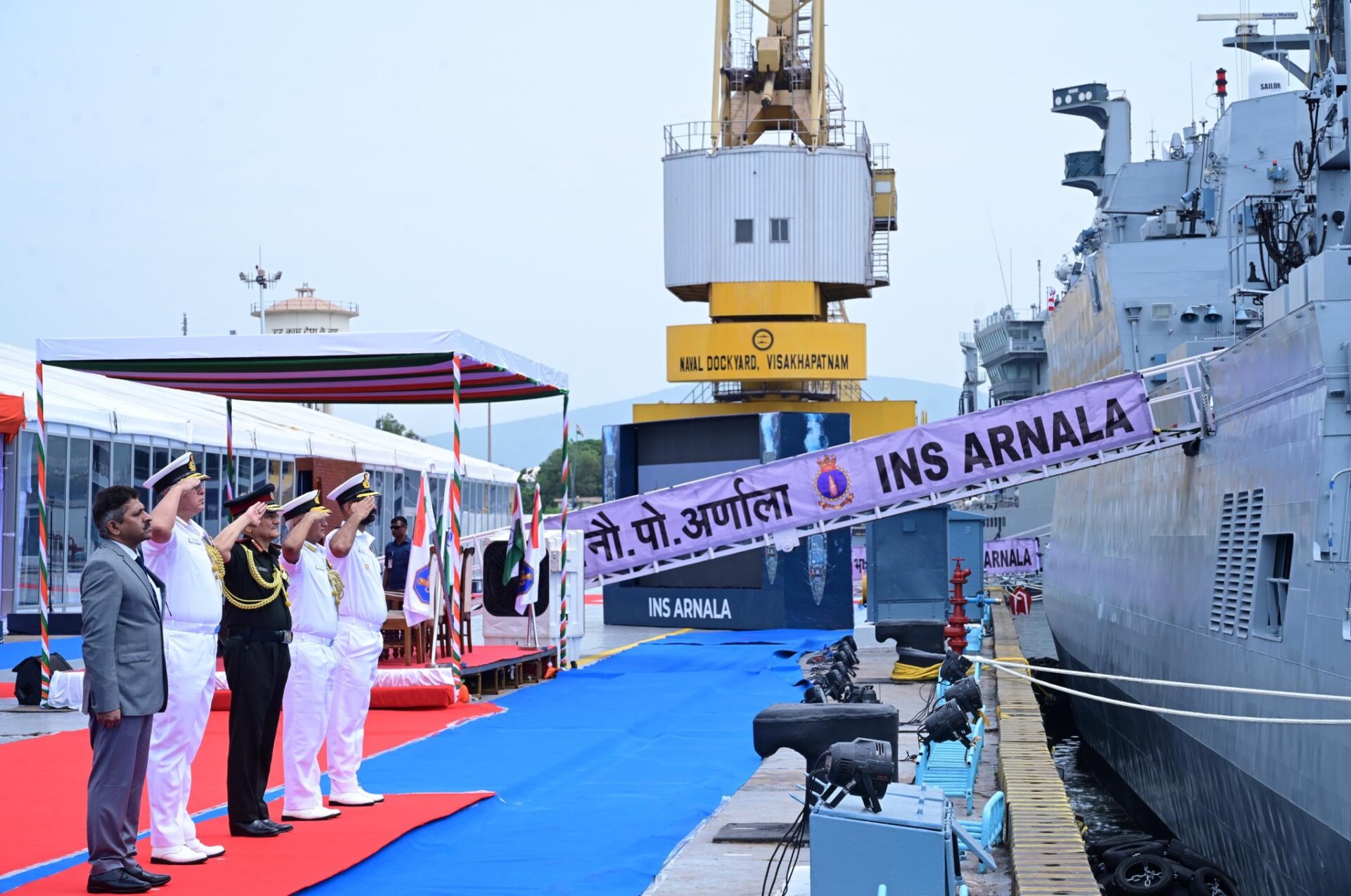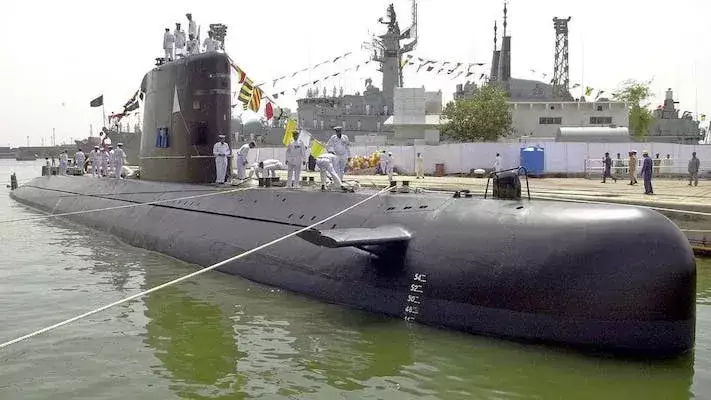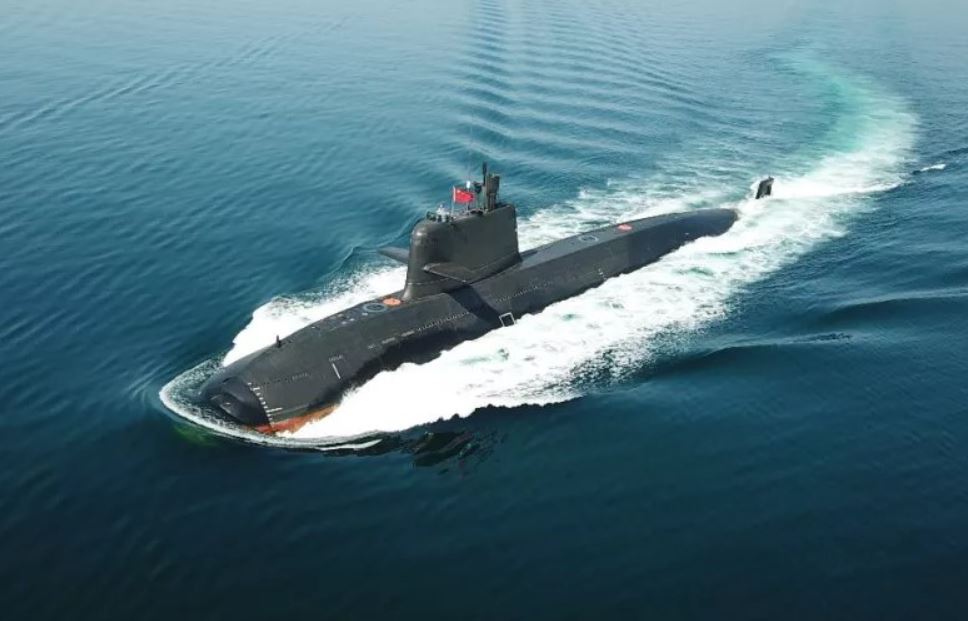India Commissions INS Arnala to Track Pakistani Submarine Threats in Shallow Seas
The induction of INS Arnala comes amid growing maritime tensions with Pakistan, whose naval strategy—hampered by limited surface combatant capability—relies heavily on undersea warfare to pose asymmetric threats to India’s sea lines of communication, ports, and offshore infrastructure.
(DEFENCE SECURITY ASIA) — In a decisive move to counter Pakistan’s expanding submarine fleet in the Indian Ocean, the Indian Navy has formally commissioned INS Arnala, its first indigenously developed Anti-Submarine Warfare Shallow Water Craft (ASW-SWC), with a clear mission to dominate and deny adversary access to India’s littoral waters.
Commissioned on June 18 at the Naval Dockyard in Visakhapatnam by Chief of Defence Staff General Anil Chauhan, the 77-metre-long INS Arnala marks a pivotal milestone in India’s coastal defence doctrine, which is increasingly focused on countering submarine threats in complex, shallow-water environments.
The induction comes amid growing maritime tensions with Pakistan, whose naval strategy—hampered by limited surface combatant capability—relies heavily on undersea warfare to pose asymmetric threats to India’s sea lines of communication, ports, and offshore infrastructure.
With the operational deployment of Agosta-90B submarines, some retrofitted with Air Independent Propulsion (AIP), and the expected induction of eight advanced Hangor-class submarines from China, Islamabad’s undersea fleet represents a growing challenge to India’s maritime dominance, particularly in the Arabian Sea.
Indian intelligence reports indicate that Pakistani submarines may attempt to penetrate shallow coastal zones—some only 50 to 60 metres deep—to acquire torpedo firing positions against high-value Indian targets, including naval bases, commercial ports, and carrier battle groups operating nearshore.
INS Arnala has been designed precisely to counter this form of low-visibility intrusion, boasting a diesel engine-waterjet propulsion system that delivers high speed and unmatched manoeuvrability in confined and shallow maritime spaces.
With a displacement of 1,490 tonnes, Arnala is the largest Indian naval platform to be equipped with this propulsion architecture, giving it a unique edge over conventional propeller-driven ships when operating in tight, nearshore geographies where adversary submarines might lurk.

More importantly, Arnala is equipped with a sophisticated suite of indigenised underwater sensors, including a Variable Depth Sonar (VDS) system jointly developed by India’s CFF Fluid Control Ltd and Germany’s Atlas Elektronik—enabling the vessel to detect submerged targets operating beneath thermal layers that shield them from standard sonar detection.
The platform also integrates advanced Low-Frequency Variable Depth Sonar (LFVDS), Underwater Acoustic Communication Systems (UWACS), and mine-laying capability—allowing it to conduct not only ASW but also low-intensity maritime operations, underwater surveillance, and defensive interdictions in congested coastal zones.
Indian defence planners stress that unlike destroyers and frigates—designed for open-ocean multi-domain warfare—Arnala-class warships are built for defensive ASW operations from the outset, focused on eliminating submarine threats in chokepoints, harbours, and along the 7,500-kilometre-long Indian coastline.
“Since there is a possibility of the adversary’s submarines being required to navigate littoral (coastal) zones with depths as shallow as 50 to 60 metres to achieve effective torpedo firing positions, Arnala is engineered to detect, track and engage such threats at stand-off ranges, mitigating risks to high-value surface assets operating in proximity,” the Ministry of Defence stated.
This makes Arnala not just a ship, but a strategic shield for India’s coastal command, capable of identifying, tracking, and if necessary, engaging submerged threats at standoff ranges—before they get within lethal torpedo range.
The commissioning of INS Arnala also signals a significant evolution in India’s naval doctrine, transitioning from a blue-water power projection posture to a hybrid model that prioritises persistent undersea surveillance and response capability in littoral theatres.

As Pakistan prepares to field the Chinese-origin Hangor-class AIP submarines—reportedly based on the Type 039A Yuan-class—India’s response has been to saturate its own nearshore with dedicated ASW vessels like Arnala, designed to deny undersea freedom of manoeuvre to any adversary.
The warship’s commissioning marks the first of 16 ASW-SWC platforms planned by the Indian Navy—eight of which are being constructed by Garden Reach Shipbuilders and Engineers (GRSE), with the remainder to be produced by Cochin Shipyard Limited (CSL), ensuring seamless coastal ASW coverage.
Arnala’s construction features over 80 percent indigenous components, developed in collaboration with Bharat Electronics Limited (BEL), L&T, Mahindra Defence, and MEIL, furthering the Modi government’s ‘Aatmanirbhar Bharat’ (self-reliant India) defence manufacturing initiative.
Beyond hardware, INS Arnala embodies a critical doctrinal response to Pakistan’s strategic reliance on submarines for naval parity—a capability that remains one of Islamabad’s most potent options in any future maritime conflict.
According to senior naval sources, “Given Pakistan’s limited inventory of modern surface combatants and the absence of dedicated ASW platforms, its naval strategy in a conflict scenario is expected to rely heavily on submarines.
In this environment, the Arnala-class is positioned to play a critical role in securing India’s coastal waters, thereby allowing larger Indian naval assets to operate with greater operational flexibility in offensive or expeditionary roles.”

The importance of shallow-water ASW capability is further amplified by the shifting geopolitics of the Indian Ocean Region, where Chinese influence and technology transfers to Pakistan are altering the balance of power at sea.
As Chinese shipyards continue constructing Hangor-class boats for the Pakistan Navy under Project Hangor-II, India is racing to fortify its coastline with an undersea shield of its own—backed by indigenised sonar systems, acoustic barriers, and shallow-water dominance platforms like the Arnala.
With maritime conflicts in the 21st century increasingly defined by stealth, sensors, and sonar shadows rather than surface firepower, the Indian Navy’s commissioning of INS Arnala sends an unambiguous message: Pakistan’s submarines will find no sanctuary in India’s coastal waters.
“This platform represents a quantum leap in our ability to detect, track, and if required, engage enemy submarines operating close to our shores. Its role will be vital in deterring Pakistan’s asymmetric undersea threat,” said Indian Navy officials.
As tensions simmer in the Indian Ocean’s northwestern quadrant, the arrival of INS Arnala reinforces New Delhi’s commitment to maritime deterrence—ensuring that the murky depths near its shores remain hostile to intruders and secure for the nation.
The Silent Threat: Pakistan’s Submarine Fleet and Its Strategic Impact on South Asia’s Maritime Balance
Though modest in size, the Pakistan Navy has long made its submarine arm the core of its naval deterrence, projecting asymmetric power in a region where undersea warfare is increasingly defining strategic outcomes.
With a limited surface combatant fleet and the absence of robust integrated maritime air defence, Pakistan’s naval doctrine leans heavily on its ability to operate undetected beneath the surface, striking high-value targets such as Indian aircraft carriers, commercial ports, and strategic naval infrastructure.
Currently, Pakistan’s undersea fleet comprises five submarines, including three upgraded Agosta-90B “Khalid-class” diesel-electric attack submarines, originally of French origin, now retrofitted with Air Independent Propulsion (AIP) systems for extended submerged endurance.
The Agosta-90B fleet has undergone significant combat systems upgrades, incorporating modern fire control, improved passive sonar, and advanced weaponry such as the DM2A4 heavyweight torpedoes and SM39 Exocet anti-ship missiles, turning these boats into formidable littoral and deep-water hunters.

However, the real transformation of Pakistan’s submarine capability lies in the acquisition of eight Hangor-class submarines under construction by China Shipbuilding Industry Corporation (CSIC)—based on the Chinese Type 039A (Yuan-class) platform, renowned for its acoustic stealth and endurance.
Four of these Hangor-class boats will be built in Pakistan by Karachi Shipyard & Engineering Works (KSEW), significantly enhancing local shipbuilding expertise and maritime industrial depth through high-end technology transfer.
The new Hangor-class submarines are expected to feature Stirling AIP systems, advanced flank-array sonar, digital combat systems, and 533mm torpedo tubes, with the likely integration of YJ-82 submarine-launched anti-ship missiles, making them serious strategic game-changers in the Arabian Sea.
Though lacking a nuclear-powered submarine fleet, Pakistan’s silent service is widely viewed as its most lethal arm, capable of threatening India’s surface dominance and maritime access in a full-spectrum conflict scenario.
Adding to regional concern, Pakistan has already tested the Babur-3 submarine-launched cruise missile (SLCM)—a nuclear-capable, sea-based deterrent that could potentially be deployed aboard upgraded Agosta or future Hangor-class vessels, marking Islamabad’s path toward establishing a credible second-strike capability.
If successfully inducted and operationalised, Babur-3 would place Pakistan among a select group of nations with a nuclear triad at sea, fundamentally altering deterrence dynamics in South Asia and introducing an underwater nuclear dimension to regional tensions.
China’s role in this strategic evolution is undeniable, as the Hangor program forms a key element of Sino-Pak maritime cooperation, enabling Beijing to project influence into the Arabian Sea while bolstering Pakistan as a regional counterweight to India’s growing naval capabilities.


